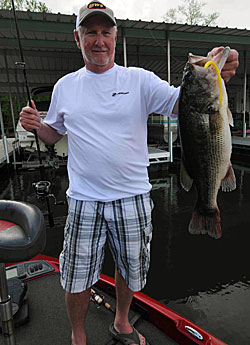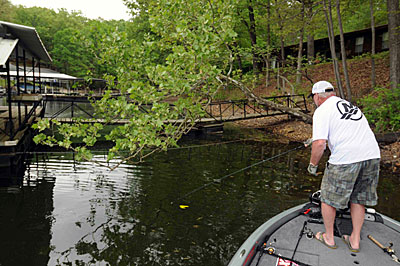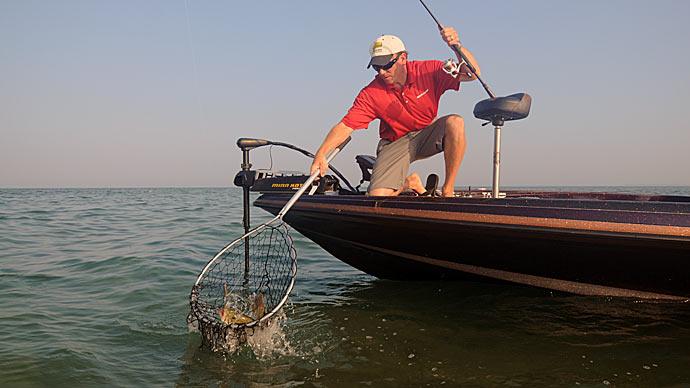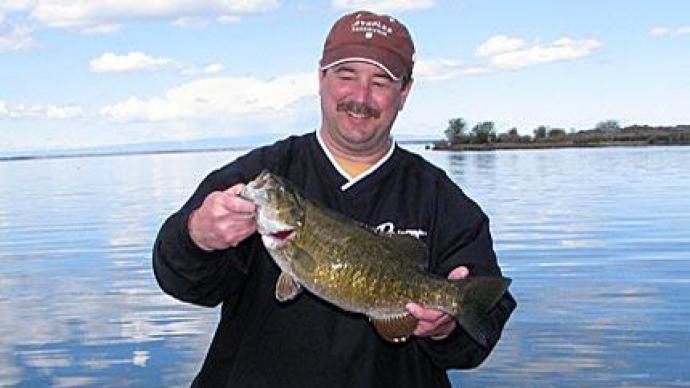
When pollen coats the water surface of Ozark reservoirs, Mike Malone knows it’s time to throw a floating worm.
The pollen coating on the surface signifies bass are bedding in Malone’s part of the country, but the tournament veteran suggests you can use other signs of spring in your region to determine when bass are spawning. Malone opts for the floating worm when the spawn is on, a finesse bait produced for him for 20 years.
“It’s a stealthy, finesse bait that doesn’t make much noise when it hits the water,” he says. “You can skip it under cover such as boat dock ramps, cables and tree limbs, etc., in a real quiet presentation. It works best during the spawn when the fish are pretty skittish.”
“Many times, I have been able to fish behind guys who were flipping a jig, a worm, or a tube and catch multiple fish with the worm,” Malone says. “I have had many 20-pound bags throwing that worm. It’s just a timing deal to catching the big ones, and it is a deadly bait for three or four weeks in the spring.”
The Missouri angler will throw the floating worm in sunshine or overcast weather, but wind creates problems for him since it tends to blow his line and unweighted worm too much. “Wind is taboo,” he says.
Finding the spawning banks is the key to Malone’s floating worm technique. On his home waters of Lake of the Ozarks, Malone looks for pea gravel pockets or clay banks protected from the wind. He also throws the worm along indentations of bluff banks that hold spawning bass.
Malone’s favorite bait for this presentation is a 6-inch Zoom Trick Worm in bright hues such as yellow and bubble gum, but occasionally he will throw a green pumpkin or bullfrog color worm to imitate bluegills. He recommends experimenting with different colors until you find one the fish seem to prefer. “The fish get conditioned to seeing stuff repeatedly, so anything different is probably going to work,” he says.
The Trick Worm is rigged wacky style by impaling a 1/0 Gamakatsu Drop Shot Hook slightly above the worm’s egg sack which gives the worm a fluttering action. “I want that worm to pulsate at both ends when I twitch it,” Malone says. His floating worm tackle consists of a 6-foot, 8-inch St. Croix Legend Elite medium action/extra fast tip spinning rod and Lew’s Custom Pro Speed Spin spinning reel filled with 10- to 20-pound test Seaguar Smackdown braided line in a stealth gray.

Making long-distance deliveries is a key to Malone’s floating worm tactic. “It is pretty important to make long, long casts if the water is clear because typically those fish will see you by the time you see them,” he says. “If I can make a long cast into an area where I can see beds, but I don’t see any fish, that is a good thing because those fish are just in the shadows off the beds. Nine out of 10 times, I can catch one there.” He also turns off his electronics to prevent spooking these shallow fish.
Even though rigged without a weight, the Trick Worm sinks slowly throughout Malone’s presentation. Most of the time, Malone retrieves the worm like a jerkbait with a twitch-twitch-pause cadence. He lets the worm sink for a second before repeating the sequence. The tournament competitor notices some days the fish want the worm moving, but on other days he has to let it sink to depths of 4 to 6 feet to trigger bites.
Since bigger bass usually inhale the worm, Malone sets the hook immediately when he feels a tick. “I reel up the slack, and I pop them,” he says.
If he notices a bluegill biting on the worm, he lets the sunfish pull until it drops the worm and then gets ready for a bigger bite. “A lot of times, that is when I catch a good bass because they hate bluegill,” he says.
The floating worm also serves as a good follow-up lure when a bass blows up and misses a Luckycraft Gunfish topwater plug Malone also likes to throw during the spawn. “Those big fish, if they don’t kill (the topwater lure), they slap at it,” Malone says. “So they are exposed then, and I drop my Talons (shallow-water anchors), and I throw that floating worm on them. Seventy-five percent of the time, I will catch them then.”
Malone recommends having plenty of worms on hand when the floating worm bite is on since you might be going through three to four bags of your favorite colors while catching 50 to 100 fish a day. The worm will produce both numbers and quality fish during the spawn. “I have caught a bunch of fish between 4 and 6 pounds on it,” says Malone, whose biggest bass caught on a floating worm was a 7-pounder.
BassResource may receive a portion of revenues if you make a purchase using a link above.




